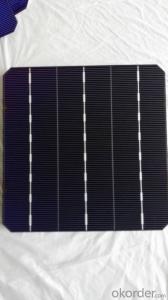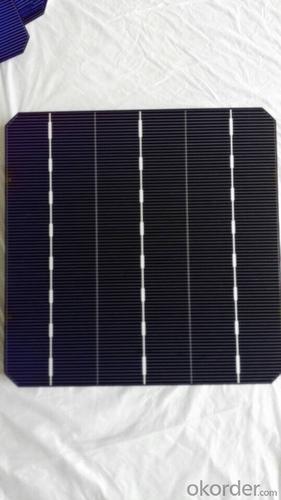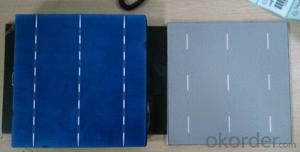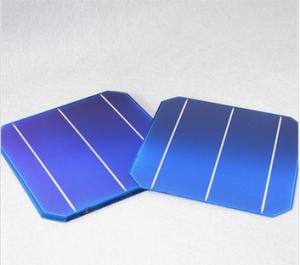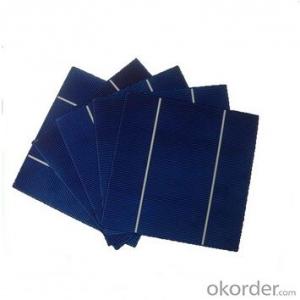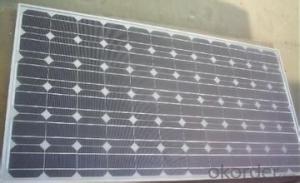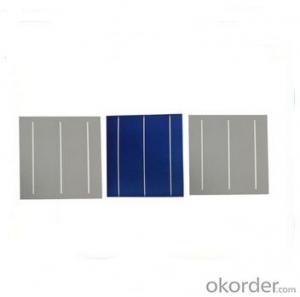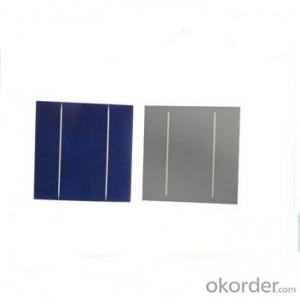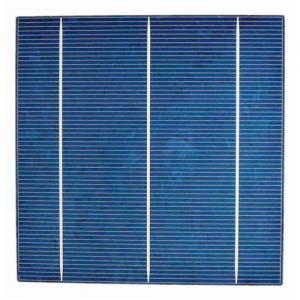Polycrystalline Solar Cells 156*156
- Loading Port:
- China Main Port
- Payment Terms:
- TT or LC
- Min Order Qty:
- -
- Supply Capability:
- -
OKorder Service Pledge
OKorder Financial Service
You Might Also Like
Mono Solar Cell 156mm Details:
| Minimum Order Quantity: | 4000w | Unit: | watt | Loading Port: | SHENZHENPort |
| Supply Ability: | 1GW Per Year | Payment Terms: | TT OR LC |
Product Description:
Details Of Mono Solar Cell 156mm
Specifications Of Mono Solar Cell 156mm
1.Mechanical data and design
Format | 156 mm × 156 mm ± 0.5 mm |
Thickness | - 210 μm ± 40 μm |
Front(-) | 1.5 mm bus bars (silver),blue anti-reflection coating (silicon nitride) |
Back (+) | 2.5 mm wide soldering pads (silver) back surface field (aluminium) |
2.Temperature Coefficient of Cells
Voc. Temp . coef.%/K | -0.35%/K |
Isc . Temp . coef.%/K | +0.024%/K |
Pm. Temp. coef.%/K | -0.47%/K |
3.Electrical Characteristic
Efficiency (%) | Pmpp (W) | Umpp (V) | Impp (A) | Uoc (V) | Isc (A) | FF (%) |
18.35 | 4.384 | 0.526 | 8.333 | 0.63 | 8.877 | 78.3% |
18.20 | 4.349 | 0.526 | 8.263 | 0.63 | 8.789 | 78.54% |
18.05 | 4.313 | 0.525 | 8.216 | 0.63 | 8.741 | 78.32% |
17.90 | 4.277 | 0.524 | 8.161 | 0.629 | 8.713 | 78.04% |
17.75 | 4.241 | 0.523 | 8.116 | 0.629 | 8.678 | 77.70% |
17.60 | 4.206 | 0.521 | 8.073 | 0.628 | 8.657 | 77.36% |
17.45 | 4.170 | 0.519 | 8.039 | 0.628 | 8.633 | 76.92% |
17.30 | 4.134 | 0.517 | 8.004 | 0.626 | 8.622 | 76.59% |
17.15 | 4.098 | 0.516 | 7.938 | 0.625 | 8.537 | 76.80% |
17.00 | 4.062 | 0.512 | 7.933 | 0.625 | 8.531 | 76.18% |
16.75 | 4.002 | 0.511 | 7.828 | 0.625 | 8.499 | 75.34% |
16.50 | 3.943 | 0.510 | 7.828 | 0.625 | 8.484 | 74.36% |
4.Intensity Dependence
Intensity [W/m2] | Isc× [mA] | Voc× [mV] |
1000 | 1.00 | 1.000 |
900 | 0.90 | 0.989 |
500 | 0.50 | 0.963 |
300 | 0.30 | 0.939 |
200 | 0.20 | 0.920 |
Advantage Of Mono Solar Cell 156mm
1: high quality cell, Level A cell
2: Dimensione:125*125mm Diagonal:150mm / 165mm
Dimensione:156*156mm Diagonal:200mm
3: Qualified certification: TUV,CE certification.
4: Warranty: five years for whole unit
Usage/Application Of Mono Solar Cell 156mm
Monocrystalline solar cells are currently the fastest developing a solar cell, its structure and production process has been finalized, the products have been widely used for space and ground. Such solar cells with high purity silicon rods as raw materials. Silicon rods, material performance indicators in order to reduce production costs, and now solar terrestrial applications such as the use of solar grade somewhat relaxed. Some semiconductor devices can also be used for processing materials and discard the head and tail of silicon materials, solar cells after re-drawn into a dedicated silicon rods.
Packaging & Delivery Of Mono Solar Cell 156mm | |
Packaging Detai | Packaging Detail:Export Carton and Pallet or under customer request. |
Delivery Detail:10-20days | |
- Q: Can solar cells be used for powering concert venues?
- Yes, solar cells can be used for powering concert venues. Solar panels can be installed on the rooftops or surrounding areas of the venue to harness sunlight and convert it into electricity. This renewable energy source can help reduce reliance on traditional power grids and decrease carbon emissions associated with concert operations. While the size and capacity of the solar system would depend on the energy needs of the venue, it is a viable option for powering concert venues in a sustainable and environmentally friendly manner.
- Q: Can solar cells be used in areas with high pollution?
- Yes, solar cells can be used in areas with high pollution. While pollution can reduce the efficiency of solar cells, they can still generate electricity in such areas. However, regular cleaning and maintenance may be required to ensure optimal performance.
- Q: What is the impact of fire hazards on solar cells?
- Fire hazards can have a significant negative impact on solar cells. High temperatures caused by fires can damage or melt the delicate components of solar cells, leading to a decrease in their efficiency or complete malfunction. Additionally, smoke and debris from fires can cover the surface of solar panels, reducing their ability to absorb sunlight and generate electricity. Therefore, fire hazards pose a serious risk to the functionality and longevity of solar cells.
- Q: Is silicon-based solar cells and silicon-based thin-film solar cells the same?
- Monocrystalline silicon polysilicon battery components with tempered glass panel aluminum alloy frame when the flat, hard board. Soft with flexible material, thin battery is a soft board
- Q: On the parallel connection of solar cells
- As for the solar cells in the string, parallel combination is Causing the damage of the battery pack, I think it is first necessary to make sure that the "combined" solar cells should have the same characteristics, and that the various parameters between them should be the same or similar, at least several major parameters must be the same, to achieve these Conditions can be combined after the combination; if the series combination in the use of a group of solar cells damaged and broken, then the other groups will not power the power supply equipment, because the entire line has been in the open state,
- Q: How do solar cells perform in extreme weather conditions?
- Solar cells can perform well in extreme weather conditions, including high temperatures and cold temperatures, as long as they are properly designed and installed. However, extreme weather events such as heavy snow or hailstorms can potentially damage solar panels. Overall, solar cells are quite resilient and can continue to generate electricity even in challenging weather conditions.
- Q: What is the payback period for installing solar cells?
- The payback period for installing solar cells can vary depending on various factors such as the cost of installation, the amount of electricity generated, and the local energy rates. However, on average, solar panel systems typically have a payback period ranging from 5 to 10 years.
- Q: Can solar cells be used in powering autonomous vehicles?
- Yes, solar cells can be used in powering autonomous vehicles. Solar energy can be harnessed using solar panels and converted into electrical energy to power the vehicle's battery or directly power its systems. This allows for a sustainable and renewable source of energy, reducing the reliance on fossil fuels and increasing the vehicle's range and efficiency. However, it's important to note that the amount of energy generated by solar cells may not be sufficient to fully power the vehicle, so it is often used in combination with other energy sources like batteries or fuel cells.
- Q: Can solar cells be used in residential applications?
- Yes, solar cells can be used in residential applications. They are commonly used to generate electricity for homes, providing a clean and renewable energy source. Solar panels are installed on rooftops or in yards, capturing sunlight and converting it into usable electricity for various household needs. This helps reduce reliance on traditional power grids and lowers carbon emissions, making it an environmentally friendly and cost-effective solution for residential energy needs.
- Q: How do solar cells impact local economies?
- Solar cells can have a positive impact on local economies by creating jobs in the renewable energy sector, attracting investments, and reducing energy costs for businesses and households. Additionally, the deployment of solar cells can stimulate economic growth through increased demand for related goods and services, ultimately contributing to the development of sustainable and resilient local economies.
Send your message to us
Polycrystalline Solar Cells 156*156
- Loading Port:
- China Main Port
- Payment Terms:
- TT or LC
- Min Order Qty:
- -
- Supply Capability:
- -
OKorder Service Pledge
OKorder Financial Service
Similar products
Hot products
Hot Searches
Related keywords
